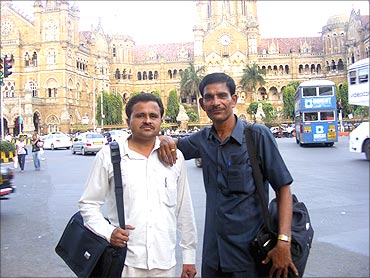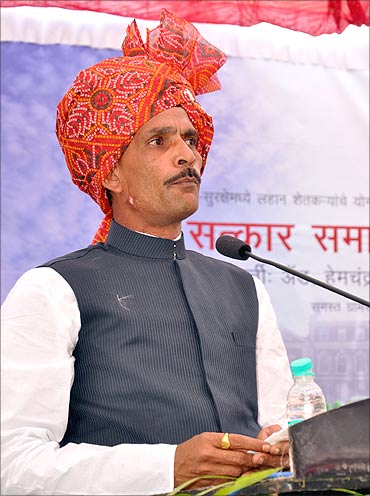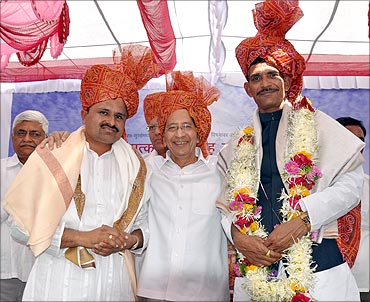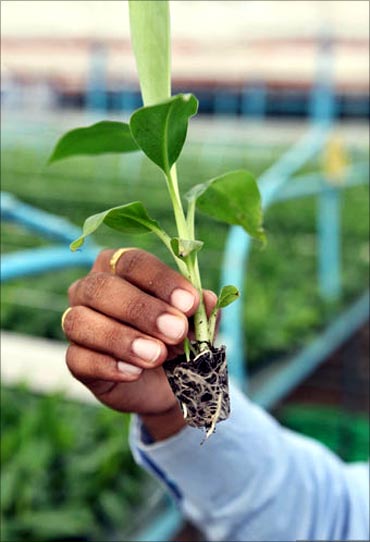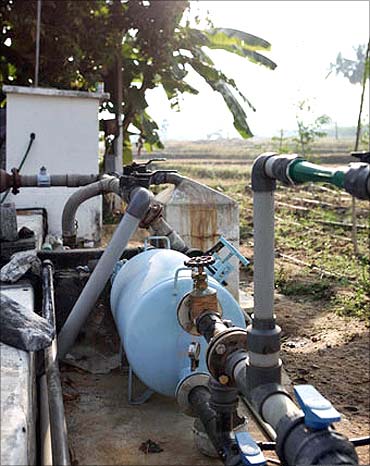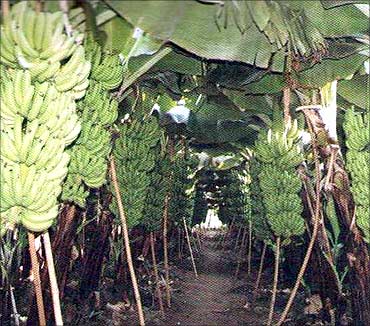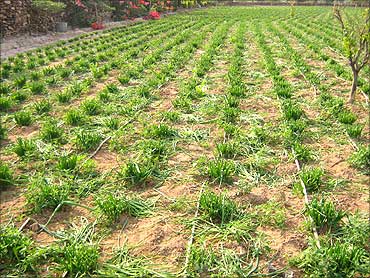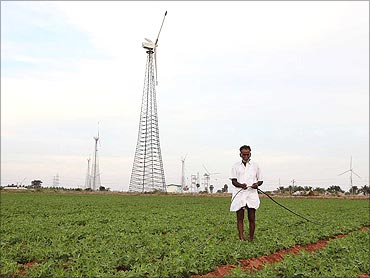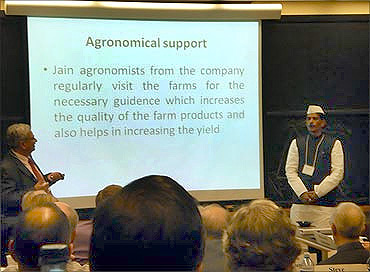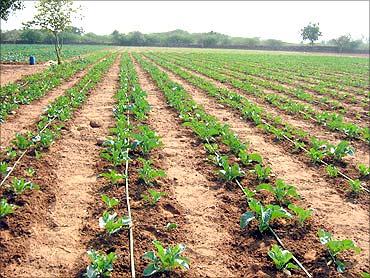 | « Back to article | Print this article |
From Jalgaon to Harvard: A farmer's success story
In a state that tops in the number of farmer suicides across the country, the success story of two farmers from Jalgoan is a shining example of how technology and innovative cultivation methods can transform the agrarian economy and uplift the lives of millions of farmers.
In this two part series, we take you through the success stories of two farmers.
Job loss, financial problems and meagre income from a small farm is history for Rajendra Hari Patil, who now earns Rs 25 lakh annually.
It has been an incredible journey for Rajendra Hari Patil and Hemchandra Dagaji Patil who traveled from Jalgaon to the Harvard Business School to talk about their success.
Part 2: How lawyer-turned-farmer Hemachandra Patil adopted innovative ways to see record breaking harvest at his farm
Photographs, courtesy: Jain Irrigation
Click NEXT to read on
From Jalgaon to Harvard: A farmer's success story
Suraj nikaltehi roshni dethi hai
Phool khilte hi khusboo dethi hai
Zindagi may kuch karne ka tamana hai agar dil may
Zameen to kya aasman bhi saath dethi hai
Rajendra Hari Patil is reminded of this inspiring couplet before he walks to his vibrant fields every day. The vast expanse of greenery is his inspiration to live and work hard.
A high school teacher-turned farmer, Rajendra's life has been full of uncertainties since childhood. His father, a farmer, passed away when he was very young. He along with 6 brothers worked hard in the fields to manage the house and earn enough money for their education. "It was a tough life but the struggle itself was a learning experience. My mother took lot of trouble to raise us. So we became very independent," says Rajendra. All of them eventually turned out to be school teachers.Click NEXT to read on
From Jalgaon to Harvard: A farmer's success story
As a teacher, he has a respectful job in the village. He got married to a teacher as well. But destiny willed otherwise.
The biggest blow came when he lost his job. There was nothing he could bank on except the 1.5 acres of family property.
"I decided to try my luck with farming as it was difficult for me to get another job. Everyone including my wife were disappointed. I started going to the fields but I realised that with such a small area, he could hardly earn any money. I took 6 acres on lease as well," reminisces Rajendra.
Without money, it became difficult for him to manage even the household expenses.
Click NEXT to read on
From Jalgaon to Harvard: A farmer's success story
As every other farmer in the region, he also practiced traditional farming till he saw some success stories of farmers on television.
They had adopted newer methods of farming like drip irrigation and tissue culture.
In 2006 he approached Jain Irrigation, a company that manufactures drip and sprinkler irrigation systems and components.
Besides supplying drip irrigation equipment, the company also helped him with seeds, tissue cultured plants, micro-irrigation systems and advice from agronomists.
"Rajendra and Hemachandra are just representatives of thousands of successful farmers who have taken up newer technologies and drip irrigation. In India, Maharastra has the maximum number of farmers adopting drip irrigation. Now, there is more demand from farmers in Andhra Pradesh, Gujarat, Karnataka and Tamil Nadu also," says Dilip Kulkarni, president Agro Foods, Jain Irrigation.
Click NEXT to read on
From Jalgaon to Harvard: A farmer's success story
It was a turning point in his life. "I started off with 10,000 tissue culture saplings of bananas in 2006. I got a good harvest after 10 months. In 2007, I planted 18,000 saplings.
The total investment per plant is Rs 55.
The yield was truly God's gift for me. We got a yield of 28 kilogram per plant. Eleven trucks were hired to carry the harvest to the market. On the way, we got down and sought the blessings from Bhavarlal Jain, founder of Jain Irrigation.
"In 3 years time, I took 60 acres of land on lease and cultivated 5 lakh saplings. While in traditional farming the loss is up to 35 per cent, with tissue culture the loss is just 5 per cent. We get Rs 25 per kilo per plant," says Rajendra.
Click NEXT to read on
From Jalgaon to Harvard: A farmer's success story
Out of the total irrigated area in India, only 2 per cent is under drip irrigation.
"Many farmers in northern states have plenty of water. They have a misconception that drip irrigation is not useful. We have found the crop yield rise by 2 to 3 times in every state," Dilip Kulkarni explains.
The cost of installing the equipment could vary from Rs 15,000 to Rs 40,000 per acre. While the government offers a 50 per cent subsidy, not all small farmers can afford to install the drip irrigation system.
Click NEXT to read on
From Jalgaon to Harvard: A farmer's success story
The banana yield rose to 40-45 metric tonnes per acre from 22-24 metric tonnes per acres.
The profits were encouraging as it rose to 3-fold. Rajendra now earns Rs 25 lakh annually. Rajendra leads a better life today.
He commands lots of respect. He no longer worries about losing the teacher's job. "I would have never tried my luck with farming if I had not lost my job. I do no regret it anymore. This job gives me a lot of satisfaction," says Rajendra.
Rajendra's path to success has not been easy.
Click NEXT to read on
From Jalgaon to Harvard: A farmer's success story
His day starts at 7 am. He drives to the field twenty kilometers away daily. He is at the fields till 9 almost every day.
"The field never tells you what to do. Even 24 hours is less for a farmer like me," says Rajendra. Besides working hard himself, he also has to monitor the work of the labourers.
"It is difficult to get good workers. They do not come for work everyday. The government offer rice for Rs 2 per kg so why should people work hard. The worker takes things so easily," says Rajendra.
Click NEXT to read on
From Jalgaon to Harvard: A farmer's success story
A farmer can never be sure of the final yield as climate is a major factor for a good crop yield.
"The ideal temperature should not vary beyond 16-44 degree celcius for tissue cultured crops but this time temperature has risen up to 47 degree celsius. Our production will be affected as the temperature has not been stable. When the production is less, the price is high and vice versa so a farmer doesn't benefit much from the price rise," he says.
Click NEXT to read on
From Jalgaon to Harvard: A farmer's success story
"It is a tough life for farmers in India. God is the only hope for farmers. In Jalgoan, out of the 120 hectares of land, only 25 hectares have got a subsidy for agriculture. Unless, government and banks helps the farmers with timely loans, how can we progress," asks Rajendra.
Recently, the government of Maharashtra felicitated him with Udyan Pandit Award-2010 for his success. He also won the 'Dr Punjabrao Deshmukh Krishi Ratna Puraskar' in 2009 from Bharat Krushak Samaj, New Delhi.
"I feel this kind of awards should be stopped. There is no respect for farmers in India. What is the purpose of such awards when they cannot help us when we are in need. Farmers should instead have a say in policy making," Rajendra explains.
Click NEXT to read on
From Jalgaon to Harvard: A farmer's success story
"My life has changed quite a bit. I have a great respect. People from far off places call me to their fields to guide them. But I still live in a rented place," Rajendra says.
He is happy that he has enough to keep his family happy. His children go to English-medium schools.
His son is in the 8th standard while daughter is in the 5th. "I always tell them to value a farmer's money and hope they can do something good for the farmers and agriculture," he says.
The journey doesn't end with this success. Rajendra feels he has miles to go. "My earning is ploughed back into the farms. I feel the farms need it the most. Being educated helps as he knows more about plants, fertilizers and the technologies that can be used," he says.
Click NEXT to read on
From Jalgaon to Harvard: A farmer's success story
The Harvard experience
The first flight he took was to America. Jain Irrigation had organised a trip for two farmers from Jalgoan to go to Harvard Business School for a presentation.
"It was a great experience. I had never imagined that I would travel to America and meet so many eminent people.
Professors there asked tough questions like, 'Why are there so many farmer suicide if you have the latest technologies'. He says one cannot compare an Indian farmer with an American. A person with 4 acres of land is considered a small farmer in India whereas in America a person with 4000 acres is a small farmer," he observes.
Rajendra was impressed to see how America practices mechanised farming successfully. He was envious of farmers who did not face problems to avail loans and financial assistance for farming.
Click NEXT to read on
From Jalgaon to Harvard: A farmer's success story
Future plans
"Our farmers still struggle to get money on time so it affects the farming cycle. Many of them end their lives unable to bear the pressures of farming," Rajendra says.
He hopes the government takes more interest in helping farmers as thousands of farmers live in penury. On his own initative, Rajendra tries to reach out to as many small farmers and guides them.
He plans to join hands with other farmers, take 50 acres of dry land on lease and turn it into one of the best farms.
"It is a big dream which will take an investment of Rs 3 crore (Rs 30 million). I can invest about 20 per cent of this and hope I will be able to get loans to make this a reality," says Rajendra.The land will then be used as a demonstration field. "I will train and guide other farmers free of cost. I wish to see many more success stories in the agriculture sector," says a confident Rajendra.
